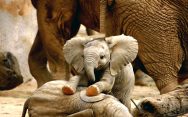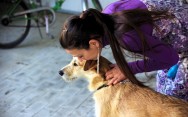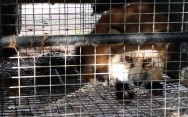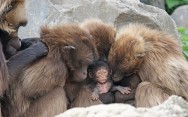Blog Archives
Home -
Posts tagged "Animal Cruelty" (Page 3)
The manatee was swimming around in Florida’s waters, when Trump supporters lured, then detained the animal to scratch a slogan into the animal’s back. The Trump supporters etched the word “Trump” into the algae on the manatee’s back. It was an act that must have taken a while to complete. The letters were 12-14 inches in height. The animal was discovered within days of the Capitol insurrection
Even though the animal appears to have been unharmed, we don’t know what harassment took place while the animal was detained. It’s possible that the animal didn’t resist because it was hurt or injured. The idea that an animal is nothing more than a billboard, a lifeless prop humans can etch slogans onto is what makes this incident horrifically disturbing. The animal was harassed, violated but more generally, it was made to stand for a human ideology that has no concern for any obstacle that stands in its way, even if that obstacle is a living being.
A “hands off” approach in Florida means that people are prohibited from harassing manatees – ie chasing, touching or riding. After this incident, there have been calls for a strict 100 percent hands off rule for approaching manatees. Human behavior towards animals clearly shows it’s not always in animals’ best interests to trust humans.
The figures show that animal abuse and human abuse is a revolving door. Domestic abusers abuse dogs and companion animals. Serial killers start with small animals. We must never make the mistake of seeing the suffering of any living being as meaningless. Violence is violence. The entitlement of the people involved in harassing this living creature only communicates the hideous violence of the Trump ideology and its lack of regard for any creature that gets in its way.
https://edition.cnn.com/2021/01/12/us/manatee-with-trump-on-its-back-trnd/index.html
https://www.miamiherald.com/opinion/op-ed/article248668315.html
“Please forgive me. If I don’t kill you, I can’t feed my family” was the desperate apology a slaughterhouse worker used to whisper to the dogs in their cages in the Cambodian slaughterhouse where he used to work. The worker burst into tears as he described killing up to 6 dogs a day in a Cambodian slaughterhouse. Unlike workers in slick Western meat processing plants who are removed from the killing, Cambodian workers who participate in horrific violence on a daily basis fully experience the reality of what they are doing.
The dogs themselves are rounded up and put into cages and then suffer a drawn-out, tortuous end to their lives. They are transported to the slaughterhouses in crowded cages huddled with other dogs, and kept in rusty cages before being killed. The dogs are killed in brutal, horrific ways with no agreed upon system of killing. Some are hung from trees, others are drowned in fetid water. Some are strangled. Some are stabbed and some are beat over the head. Workers learn to prefer beating dogs over the head because it’s quicker, or drowning them in closed cages so they don’t have to hear their cries.
Yet amid all the horror, somehow there is a ray of light for Cambodian dogs. The organization Four Paws, which has worked tirelessly on behalf of dogs in Cambodia, has succeeded in shutting down the worker’s former employer, one the country’s biggest slaughterhouses. If the closure of this business disrupts the supply chain, it will send a strong message about the acceptability of the dog meat trade in Cambodia. The province of Siem Reap has also decided to ban the trade. But in Cambodia over 3 million dogs a year are slaughtered for the dog meat trade. There is still so much more work to be done to turn the tide against this horrific slaughter.
Four Paws did not just shut down the slaughterhouse, it supported workers to find alternative income and helped some of them to open a grocery store. The organization follows through on an understanding of the relationship between human misery and animal misery. One begets the other as poor workers are forced to kill for a living and dogs die to make profits for rich humans who are conveniently removed from the killing. The kind of clothes that those in business wear are different from the blood-stained rags of hired animal killers, yet it is the clean suits that are the real hallmarks of mass killers.
In a poignant moment, the worker who had murdered the dogs was able to release fifteen of them from their cages when the factory shut down. This time the worker was able to whisper to the animals: “you are free now” In this moment, the workers’ freedom and the animals’ freedom were not different, they were intricately intertwined and impossible without each other.
Please visit Four Paws website and make a donation to support the important work they are doing: four-paws.us/campaigns-topics/campaigns?utm_source=google&utm_medium=grant&utm_campaign=Evergreen&utm_content=UNR1907ADGRNTevergreenBrand&gclid=EAIaIQobChMInt2_1rKq6wIVFIzICh25fAV7EAAYASAAEgLww_D_BwE
https://www.scmp.com/news/asia/southeast-asia/article/3037201/inside-cambodias-brutal-dog-meat-trade-which-claims
Mountain lions in California are isolated, dejected, without chance of finding a mate and vulnerable to poisoning, death on highways and deliberate targeting by humans. That is the picture painted by this LA Times Article, ahead of a major decision by the Fish and Game Commission that went in favor of Mountain Lions. The Fish and Game Commission have decided to review the Mountain Lions’ Endangered status over 6 years and afford them certain protections in line with this. The article delves into the ways Mountain Lions should be protected. While these considerations apply to Mountain Lions, it would be even better if some of the protections could be universally applied to protect wild animals in shrinking habitats encircled by human development.
One suggestion the article makes is that highways should not restrict Mountain Lions’ Movements. It seems a no-brainer to require green overpasses for all animals in highway development plans. The needs of wild animals to roam freely and seek food and better conditions are fundamental. Animals may not be imprisoned in Wildlife Parks but encircled by “highways of death” they may as well be.
Then there are poisons. Poisoning animals that are considered pests doesn’t just kill them in an inhumane and horrible way, it also risks the life of any other animal happening upon this poison, whether by predation or by other exposure. Poisoning “pests” is the equivalent of planting landmines in wild animals’ natural habitats. Raptors like owls, for example, are much more likely to die from anticoagulant rodenticides. These poisons induce fatal bleeding in animals. It is an unthinkably cruel way to die.
The only reason people are starting to wake up to this inhumanity is that their own pets are sometimes killed by poisons. The sad and difficult lives of Mountain Lives tell a much bigger story about life for wild animals who are forced into exile on the borders of human habitats.
Read More:
https://www.sanluisobispo.com/news/local/environment/article243374736.html
https://www.sacbee.com/news/california/article237937419.html
https://messengermountainnews.com/mountain-lions-win-major-victory-at-fish-and-game-commission-meeting/
https://www.latimes.com/opinion/story/2020-04-15/mountain-lions-protection-freeways-rat-poison-property-owners
Australia’s Capital Territory has just taken an important leap forward in the legal treatment of animals. The new laws in Australia’s Capital Territory recognize that animals can perceive and feel the world around them and have “intrinsic value.” These concepts finally depart from the legal structures which incarcerate animals as objects designed for humans’ use and abuse, and which characterize most legal systems around the world.
The laws impose sizeable fines and prison sentences for confining animals, lack of animal care and participating in cruelty to animals. They also move to restrict pet shops and the pet shop industry.
There is reason to celebrate the passing of these laws, but a good beginning mustn’t be a permanent band-aid. This article is right to point out that “animal sentience” does more to regulate treatment of pets than it does to change humans’ relationship with animals. Australian industries that harm animals won’t be expected to change. A “duty of care” is imposed on humans when they are in a relationship of care. But so many of human relations with animals are mediated through profit and product, rather than care. The new laws recognize that animals should not be humans’ property in the law. In practice they will defend the animals humans have chosen as pets, abandoning the animals victimized by industry. We can only hope that the interpretation of these laws and further activism will expand protection to animals who are still being brutalized.
Read More:
https://www.canberratimes.com.au/story/6407314/act-passes-australia-first-animal-sentience-laws/
In an ideal world, mourning the death of any living being should not bring relief for their passing. When death brings relief because a being has been suffering unimaginably however, we are glad the suffering has passed out of the world, at least. Often, the suffering of any animal comes in the form of pain or illness. In the case of Tikiri, the 70 year old elephant, her suffering was a result of years’ of slavery and abuse. The 70 year old Tikiri the elephant came to the world’s attention due to her emaciated appearance at a religious festival in Sri Lanka. The animal was used in a parade for 10 days each year. She was photographed in a skeletal, emaciated state, apparently malnourished and exhausted by her job. The elephant would march for days at this festival while hungry, exhausted and at an advanced age. Her body was covered with decorations to hide her terrible condition. Tikiri had been a working animal all her life, and was forced to march, despite being “India’s oldest elephant.”
It’s easy to forget that “fun elephant rides” for tourists are the other face of animal slavery. If tourists and those attending religious festivals boycott attractions and entertainments based on elephant slavery, unnecessary suffering could be prevented. That way, Tikiri’s suffering could at least lead to some kind of justice for others’ like her.
https://www.cnn.com/2019/09/25/asia/emaciated-elephant-death-sri-lanka-scli-intl/index.html
This Vice headline sums the Amazon situation up with the kind of bluntness that’s needed at the moment: “Sad About the Amazon Fires? Stop Eating Meat.” The article is a timely correction to the assumption that logging is the reason we are losing the Amazon rainforests. Many posting on social media accounts about the Amazon fires are unthinkingly connecting the damage to “other people”: greedy logging companies etc., when in fact the trail leads directly back to the people posting – many of whom eat meat. Cattle ranching is the leading cause of deforestation in the Amazon, and clearing lands to make way for cattle is what is causing the fires.
The growing demand for meat is driving this destruction, in particular the demand for beef. With plenty of healthy protein substitutes available, the slaughter of cattle is completely unnecessary. Industrial farming harms the environment in other ways through water pollution from slaughterhouses. Animal suffering is an inevitable byproduct of treating animals like products, to be mutilated and packaged. In the tragedy of the Amazon rainforest we can see how this approach to life has outward ripples. When we treat life like an industrial product, when we kill animals brutally, we lack the respect for other life that is ultimately needed to save our own lives and habitats.
Read More:
https://www.vice.com/en_in/article/bjwzk4/feeling-sad-about-the-amazon-fires-stop-eating-meat
There is a lesson the public has learned from recent videos of cows being violently abused on Martin’s Farms, and it’s not what you think it might be. The videos of cows are an awful spectacle that has caused Martin’s Farms to fire employees in a show of remorse and responsibility. The real lesson however is that accountability for animals’ suffering is based on the martyrdom of animals rather than concern for them. The lesson is that animals have to be hurt and to suffer before action is taken. There’s a reason for this: many dairy farms throughout the US are inspected by milk co-ops, i.e. the dairy industry itself. Farms overseen by the Maryland and Virginia Milk Co-Op (including Martin’s Farm in Pennsylvania), don’t even make inspections public record. Is it any wonder that action is only taken when it’s too late, since the dairy industry has no incentive to prevent or stop abuse? Firing workers and apologizing is not the same as systematic change and it won’t take back the suffering of the animals.
Let’s return to what happened to the dairy cows at Martin’s Farms. Cows at Martin’s Farms were punched kicked, stomped on, blasted with scalding water to make them move. An operation was performed on a cow without anesthetic. Another cow was shot with a bullet in a botched, brutal killing and then shot a second time when it didn’t work. It’s easy for humans to rest comfortably in delusions that make us feel better, that this video showed unusual cruelty, and that justice has now been done. Unfortunately it’s very likely that cruelty like this is happening at other farms, right now, with no oversight. Accountability is one thing, but that can only happen with care, concern and oversight. For animal suffering to be prevented, humans need to stop indulging in outrage and “justice” and start protecting animals over industry. Please read, share and take action:
https://forcechange.com/530234/dairy-cows-reportedly-tortured-and-abused-deserve-justice/
https://wjla.com/features/7-on-your-side/inspecting-animal-welfare-on-dairy-farms
This film is a very good example of [Christian] humanistic beliefs about the nature of human beings, and the deep ontological assumption of ontological [dis]parity. In this way of thinking we see hierarchies everywhere, with only the bishops, the Pope, angels and God outstripping the value of humans, and people of some color and gender of greater value than others. Most people cannot see a new Archimedean point of view, in which this “worlding” is replaced by one with a much more justifiable moral construction. In this film, we see dolphin families destroyed, their members vocalizing terror, puzzlement, and and deep grief. Some of the dolphins are hauled to the pier and chopped to pieces as they lie dying. Others are sold to Russian and Chinese aquariums, forever imprisoned until they die. There is nothing about this practice that is morally redeeming and, in the converse, it shows how little evolved humanity is. You should also know that Japanese “scientists” have been regularly capturing Antarctic whales for the purpose of “knowledge” when, in fact, they are taken as food.
This practice is analogous to others, in which we use animals for entertainment, clothing, food, “research,” and sexual gratification in ways that are demeaning, abusive, harmful, torturous, sadistic, and vile. Some people argue that it is our “natural” right but this is another deception by fiat. The truth is that we are a violent species, narcissistic, “speciesist”, egocentric, and capable of generating outlandish arguments that purport to serve our best interests–that our best interests always outweigh the interests of the Other. We have this way of thinking within the human population as well, as I mentioned before: power underwrites knowledge, truth and morality. Yet, we colonize other races, and colonize other species in exactly the same way with the same kind of thinking.
When we truly excavate our thinking, we always find the hidden treasure – the deep assumption – that we believe we are of greater ontological worth and value than individuals of other species. We do it with lions and tigers, wolves and bears, domestic dogs and cats, marine life, and the rest of them. “Tolerance”, moral relativism, and moral subjectivism were the worst–and least plausible philosophical positions ever proffered, for they operated as defenses against some of the most atrocious behavior we have seen. Unfortunately, tolerance is the sign of a weak person and a weak culture. It is one of the greatest deceptions ever. We must not be tolerant. Instead, we must use our reason to think–critically–about our behavior, and someone else’s. This does not mean we ought to opt for vicious objectivisms either, for they are on the other wrong side, and have as their bulwark the psychopathology of capitalism, complacence, the dangers of [Zizekian] hysteria, and claims to truth that are always underwritten by power.
Thus, this film can enlighten us to our savage Japanese cousins, but hopefully wake us up to our own “peccadilloes.” Shooting coyotes to make fancy runway Canada Goose jackets for the rich; shooting grizzly bears from fear; setting bait for wolves [near Stevensville] laced with broken glass and strychnine]; injecting primates with Ebola viruses in the lab at Hamilton; forcing elephants to give you a a circus ride, or tigers to jump through fire or be beaten; fucking dogs that have been forced into prostitution; setting cats on fire; engaging in absolutely irrational animal-model research then often usually killing and throwing the subjects into the garbage; imprisoning cows, raping them, preventing their young from suckling, then selling cheese, milk, and ice cream cones to the hoi polloi while we murder males for veal and start raping the females all over again; racing horses then herding them into the Killbox for their “meat; finding “humane” ways of raising cattle and slaughtering them to the tune of decades of poisoned water, noxious carbon and methane, and workers who suffer almost 100% PTSD for being the agents of violence.
The Anthropocene. What gets me is that some folks who are hailed as brilliant geniuses in this ontological order show up as as imbeciles in another. Moreover, even though the fallacy of the false dichotomy, the fallacy of oversimplification, and the either-or fallacy ought to be avoided, we must also avoid their dark cousin, the fallacy of obfuscation, in which we intellectuals hide inside words without fully participating in our “god-given” interrelational self, which requires us to overcome the false belief that we are at the center of anything, the masters of anything including discourse, and that from universities spring truth and goodness.
The most difficult task for any of us to is to see the Other – the radical Other – outside of our own mental categories to which we cling like children. And thus, without poiesis we will continue to be lost at sea, just like these dolphins who are slaughtered because they “belong” to us – another fallacy. The only enjoyment I get is knowing that humans will “get theirs.” This is natural justice, a deep algorithm that underwrites true natural rights.
The Cove: https://www.imdb.com/title/tt1313104/
When humans hunt animals, animals learn to fear them. They hide, they move their dwelling places, change their feeding patterns. In our limited view of animals, this might seem obvious – that animals change their behavior outwardly, as if they are automatic, soulless creatures. But the real wake-up call is that animals change internally in response to us (see this recent blog on whales’ stress response). Whole populations of animals change – they breed differently, they lay down different patterns, sometimes within a generation. The classic example that is often cited is of the moths that changed their color due to industrialization. Now it seems, elephants in Mozambique are evolving to lose their tusks. According to this article, a third of female elephants in Mozambique have no tusks, and in Gorongosa, by the 2000s, 98% of the female population had no tusks.
The threat of humans from poachers can’t be underestimated. Human poachers often target elephants from small planes or helicopters. They literally pick off elephants with tusks from above, annihilating them in front of groups of their family and friends. Elephants, like humans, are animals with strong family structures. Like a war torn human population, elephants become refugees from their own territory. They are forced to adapt, survive and live a fugitive life. There is no way to fully express the damage done to the elephant population by poachers, but it’s instructive to think of it in terms that humans would understand – war. The damage is experienced on many levels, emotional, physical and physiological. The loss of something essential to an elephant like tusks is a sign of how deep the damage can reach. Please help support African Elephants by donating to the AWF, among others.
Read More:
https://www.businessinsider.com/african-elephants-are-evolving-to-not-grow-tusks-because-of-poachers-2018-11?fbclid=IwAR2mxf0FgehljjqSAtnmoNIfhCTqRzsqKW1SIYD7UNiPvRYVY35c_EOxauA
Finally, a step in the right direction. Iowa’s infamous “Ag Gag” law has been struck down as unconstitutional. This is a law that could fine and send animal activists to prison. It prevented free speech about animal mistreatment — even worker mistreatment on industrial farms. So many atrocities went unnoticed, so much cruelty was hidden behind a wall of silence.
Ag Gag laws are a way of protecting big agriculture at the expense of animals. Industrial farming is one of the most open atrocities of our times. Terrible conditions are allowed to persist, to protect profits. Many other states have ag gag laws, so this battle is not over. Now is a good time to get educated about ag gag laws and donate to further the efforts of organizations who fight these laws and support activists who are struggling with unfair charges.








Social Media